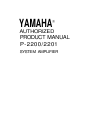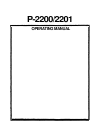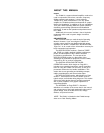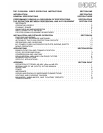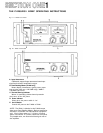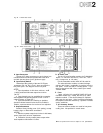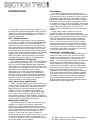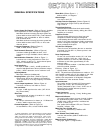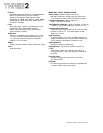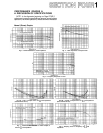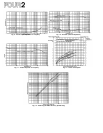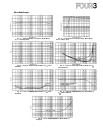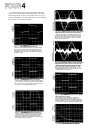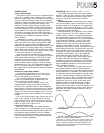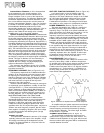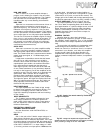
GENERAL SPECIFICATIONS
Power Output Per Channel: (Refer to Figure 3. Ambient
room temperature for tests: 25-degrees Centigrade.)
200 Watts continuous average sine wave power into
8
ohms
with
less
than
0.05%
THD,
(Total
Harmonic
Distortion), over a bandwidth of 20Hz to 20kHz,
both channels driven.
230 Watts continuous average sine wave power into
8
ohms
with
less
than
0.05%
THD,
at
1
kHz,
both
channels driven.
Frequency Response: (Refer to Figure 5.)
+0dB, -0.5dB, 20Hz to 50kHz.
Total Harmonic Distortion: (Refer to Figure 6.)
Less than 0.005% @ 50 Watts, 8 ohms, 1kHz.
Less than 0.01% @ 150 Watts, 8 ohms, 20Hz to
20kHz.
Intermodulation Distortion: (Refer to Figure 7.)
Less than 0.01% using frequencies of 70Hz and
7kHz, mixed in a ratio of 4:1, single channel power
output of 150 Watts into 8 ohms.
Input Sensitivity:
An input of +4dB* (1.23V), ±0.5dB, produces an
output of 230 Watts into 8 ohms (maximum output
power), INPUT attenuator set for maximum level.
Input Impedance:
25k-ohms, minimum (unbalanced).
Damping Factor: (@ 8 ohms / (Refer to Figure 8.)
Greater than 300 at any frequency from 20Hz to
1kHz; greater than 70 at any frequency from 20Hz
to 20kHz.
Actual Output Impedance: (Refer to Figure 9.)
Less than 0.04 ohms, from 20Hz to 10kHz.
Hum and Noise:
At least 110dB signal-to-noise ratio (l.H.F./A.S.A.
No. Z24.3-1944).
Rise Time:
3.8 microseconds, or better (10%-90% of 1 volt @
1kHz square wave output).
Slew Rate:
45 volts per microsecond, or better (at 175 Watts into
8 ohms, 200kHz square-wave input).
Channel Separation: (Refer to Figure 10.)
At least 82dB at 1kHz, at least 75dB at 20kHz.
*In these specifications, when dB represents a specific voltage,
0dB is referenced to 0.775V. "dB" is a voltage level, whereas
"dBm" is a power level. 0dBm is referenced to 1mW (0.775V
driving a 600-ohm termination). For example, when 12.3V is
fed to a high impedance, the level is designated "+24dB." When
+24dB (12.3 volts) drives a 600-ohm termination, the level is
designated "+24dBm." The level in "dB" is specified, wherever
applicable, to avoid confusion when the input is fed by various
low and high impedance sources. See the APPENDIX beginning
on Page EIGHT 1 for a further discussion of dB.
Phase Shift: (Refer to Figure 11.)
20Hz to 20kHz, ±10 degrees.
Offset Voltage:
Less than ±10mV DC.
Unit Step Function Response: (Refer to Figure 27.)
See scope photo (Page FOUR 4) and discussion,
Page FOUR 6.
Thermal Specifications:
Massive black anodized heat sinks are thermally
joined with the chassis, thereby utilizing the entire
amplifier as a heat sink.
Protection Circuits:
Thermal warning light turns on when heat sink
temperature reaches 100-degrees Centigrade.
A self-resetting thermal switch shuts down the AC
power if the power transformer winding temperature
reaches 130-degrees Centigrade. See Page SIX 13 for
power overload circuit specs.
Turn On/Turn Off Specs:
There is no turn off transient; the turn on transient
is
minimal
(see
Page
SIX
13).
Warm
up
time
is
less
than 0.2 seconds.
Power Requirements:
For the U.S. and Canadian models: AC, 120 Volts
nominal, 50-60Hz (105V min., 135V max.); 8
amperes maximum at 120V AC; 960 volt-amperes
maximum at 120 Volts; approximately 57 volt-
amperes at idle.
For other territories models: 1,300 Watts, 220 or 240
Volts AC nominal, 50-60Hz.
Efficiency: (Refer to Figure 12.)
As high as 63%; see Page FOUR 2.
NOTE: All performance specifications are made on U.S.
and Canadian models at an AC line voltage of 120 Volts
±1%, using a ±1% nonreactive load resistor at an
ambient room temperature of 25-degrees Centigrade.
Also effective for other territories' models.
Input Connectors:
One "male" and one "female" XLR connector in
parallel,
pin
2
"hot,"
pin
3
connected
to
pin
1
(shield); switchable
for
pin
3
"hot."
XLR's are un-
balanced and in parallel with two tip-sleeve
(standard) phone jacks.
Output Connectors:
Standard 3/4-inch spacing, "5-way" binding posts.
Meters and Indicators:
Two peak reading meters (one per channel) indicate
the instantaneous power output, over a 5-decade
(50dB) range. "0dB" represents 100 Watts into
8 ohms. (P-2200 only)
One "power ON" indicator LED; one "Thermal
Overload" indicator LED.
Meter Rise Time (P-2200 only):
Less
than
10
milliseconds;
(-40dB
to
0dB
on the scale).
Meter Release Time (P-2200 only):
Less
than
0.8
seconds; (0dB
to
-20dB
on
the
meter scale).
Meter Accuracy (P-2200 only):
See graph, Figure 13, Page FOUR 2.



